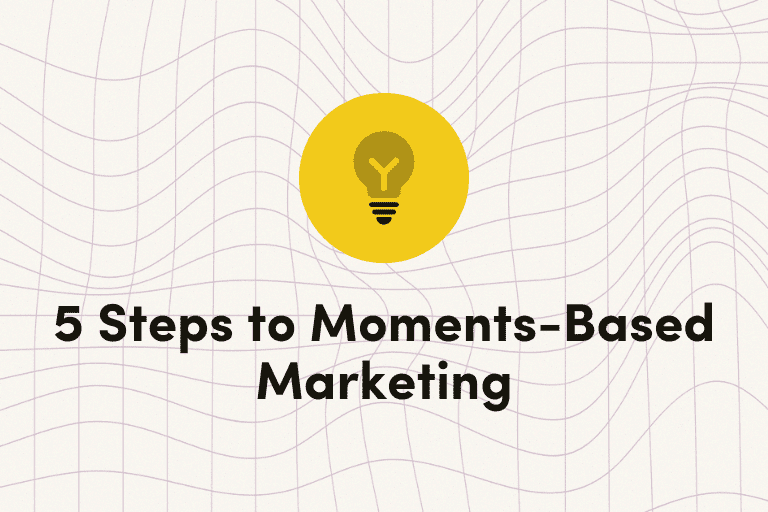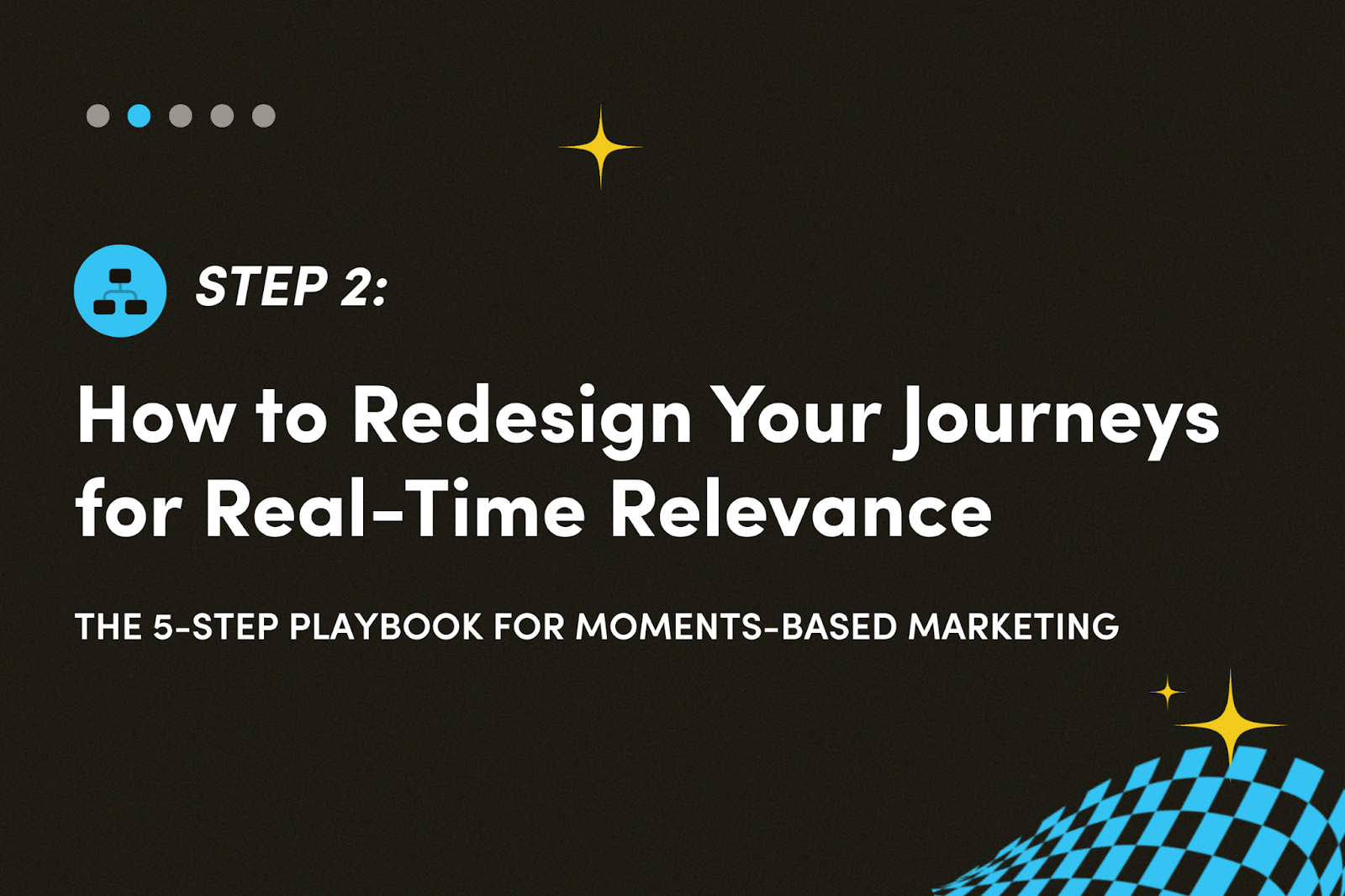| This blog is part 2 of our 5-part series on Moments-Based Marketing. Step 1 was about building a clean, connected data foundation for AI-powered marketing. In Step 2, we explore how to put that data into motion with real-time, living journeys. |
Most marketing automation still runs on rigid, rule-based workflows, built for a world that doesn’t exist anymore. Outdated “set it and forget it” flows expect customers to move in a straight line: point A to B to C. But when was the last time you saw your audience behave that way? The truth is, funnels don’t accurately reflect how people actually move–just how marketers wish they would.
That’s exactly why we need to rethink journey design as crafting experiences that evolve in real time — driven by behavior, context, and preferences — without requiring a marketer to stop and rebuild them every week.
To dig into what that looks like, I chatted with Mara Cohen, CRM Manager at ATG Entertainment, and Steven Aldrich, SVP of Marketing Services at Ragnarok. We explored how ATG migrated from static, one-size-fits-all sends to truly adaptive, cross-channel journeys using Iterable, and how Ragnarok supports brands through the messy, human side of CRM transformation: the process, the people, and the mindset shift.
| We’ll cover the top takeaways here, but be sure to check out our full conversation, Step 2: Redesign Your Journeys for Real-Time Relevance. And tune in for the next part in our series, Step 3: Scale Contextual Personalization with Modular Content. |
Why Data Hygiene Is the Backbone of Adaptive Journeys
Before a brand can design journeys that adapt to each customer moment, it needs clean, consistent, decision-ready data to power them. Data hygiene isn’t maintenance—it’s fundamental to your marketing infrastructure.
ATG Entertainment is a global live entertainment company operating theaters, ticketing, and productions across the U.S., U.K., and Europe. With that scale comes classic CRM challenges: inconsistent data across regions, unverified contacts, and audience records that make it difficult to align messaging with real-world logistics—things like performance times, venue details, or upsell opportunities such as food and beverage pre-orders or premium lounge access.
How ATG Turned a CRM Migration Into a Data Transformation
When ATG migrated to Iterable, the team viewed it not as a platform swap but as an opportunity to reset their data foundation, enabling them to support real-time personalization, cross-channel consistency, and more adaptive journey design.
Here’s how they made it happen.
1. Audit and Cleanse the Database
They began by confronting the data reality that most large organizations overlook. Fake emails. Typos. Spam traps. Ghost contacts. Instead of dragging all that baggage into a new system, they hit pause and got serious about cleaning house.
They brought in tools like Kickbox to verify addresses and remove risky or invalid records. Beyond cleaning up their email list, it was a strategic move to improve deliverability, protect their sender reputation, and make sure every journey built on that data would actually work.
2. Deliberate IP Warming
Once the data was clean, it was time to rebuild trust. ATG made IP warming a cornerstone of their strategy. Starting with their most engaged contacts, they gradually ramped up volume, letting high engagement do the talking with ISPs.
This intentional pace gave them breathing room to fine-tune as they scaled, allowing them to monitor delivery, engagement, and performance in real time. They were able to focus on ensuring their messages reached their customers and had the chance to make their intended impact.
3. Rebuild Segmentation Strategy
ATG’s old segmentation model relied on static lists and overly broad categories. It led to too many messages going to the wrong people and too few results.
Instead of “everyone who’s ever bought a ticket,” they started segmenting based on recency, frequency, and brand affinity. That shift to behavior-based criteria helped them prioritize high-intent audiences and optimize every send for deliverability and conversion. Less noise. More relevance.
4. Set Guardrails for Messaging
Personalization is powerful. However, without boundaries, it’s a ticket to the hot mess express.. To prevent fatigue and protect the customer experience, the team implemented guardrails across every journey: suppression lists, frequency caps, and logic to avoid overlapping flows.
For example, if someone had a show coming up, they were excluded from unrelated promos. That level of control gave ATG the confidence to scale personalization across email, push, and WhatsApp without worrying about message collisions or channel overload.
5. Activate Adaptive Automations
ATG launched high-impact, event-triggered journeys like abandoned cart messaging and pre-visit upsells — automations that responded to live behavior in real time. As part of their process, they documented every data point across systems, including its origin, reliability, and optimal use.
These journeys were fast and trusted. Every trigger, every condition, every message was grounded in real, validated data. Which meant they could move from “set and forget” to “set and evolve.”
Inside ATG’s Adaptive Journey Redesigns
With a clean data foundation in place, ATG took those principles and ran with them, rebuilding their campaigns into living journeys that now respond to behavior in real time:
- Abandoned Cart: If a customer bounces from the website without buying, ATG automatically sends a follow-up message within minutes, while intent is still high. But if they come back and complete the purchase, the message won’t be triggered. What used to be a generic reminder is now a timely, helpful nudge.
- Pre-Visit and Show Journeys: ATG uses real-time event triggers and Catalog data to tailor pre-show journeys by venue, ticket type, and purchase window. Early buyers get sneak peeks and upgrade options. Last-minute purchasers get a “know before you go” message and upsell reminders.
- Upsell and Loyalty Triggers: To keep VIP customers engaged, ATG built adaptive flows based on recency and spend metrics. When someone crosses a high-value threshold, they get early access offers or loyalty perks automatically. If a customer qualifies today, they could be rewarded tonight. No need to wait for the next manual upload of a list.
Real-Time Journeys Became a Performance Multiplier
By replacing static workflows with moment-based orchestration, Mara’s team unlocked measurable impact across the board.
- Higher engagement and conversion rates: Journeys triggered by real customer behavior, like abandoned cart, pre-visit, and upsell flows, consistently outperformed batch sends. Why? Timing. These messages hit when intent was high and context was clear.
- Improved deliverability with cleaner data: The data cleanse and IP warm-up helped rebuild trust with IPs. By removing risky contacts and slowly scaling sends, ATG boosted inbox placement across key providers. Opens went up, but more importantly, messages landed when and where they needed to.
- Faster campaign launches with creative agility: With modular content and centralized logic, marketers could build and deploy new email variations almost instantly. That nimbleness meant faster testing, quicker pivots, and fresher content across every channel.
- Cross-channel consistency, powered by real-time data: ATG now runs email, push, and WhatsApp on the same live data stream. So when a customer meets the criteria to enter a journey, the messages that follow are coordinated — no duplicates, no channel confusion.
|
Want to explore how real-time marketing can unlock one-to-one engagement? Download our Moments-Based Marketing Guide |
How To Operationalize CRM Change Across Teams and Markets
The hardest part of modernizing CRM programs isn’t the technology. It’s the transformation in mindset and process. The real work happens behind the scenes: shifting team behaviors, rethinking outdated processes, and creating space to experiment in the face of daily demands.
As the co-founder of one of Iterable’s agency partners, Ragnarok Steven Aldrich has supported hundreds of Iterable implementations and brings an invaluable perspective on this challenge.. Here’s how he breaks down the path to operationalizing that shift.
Platform Migration Without Losing Momentum
One of the biggest traps teams fall into during migration is the “lift and shift” approach — replicating old flows, outdated segmentation, and legacy logic exactly as they existed in the previous platform. As Steven noted, this is how brands end up paying for a modern tool to run their legacy program.
He recommends a more balanced approach:
- 60% of the program should migrate “as-is” to maintain business continuity
- 40% should be reimagined using features that support adaptive design (event-based triggers, dynamic content, AI, modular templates)
This prevents operational disruption while still allowing for innovation, with a structure that provides both stability and forward momentum.
ATG is a great example of this in practice. While warming their new IP and rebuilding foundational automations, they also rolled out a new mobile app. It was ambitious, but deliberate. The opportunity to reimagine their customers’ experience and leverage the new capabilities now available to them built internal confidence and momentum for future changes.
Scaling Personalization Across Global Markets
Global brands face a different challenge: how do you adapt journeys to regional needs without building operations that look like Frankenstein’s monster? Steven’s advice here is straightforward: Start with a single, universal journey logic at the top — then localize through content and data.
That means:
- One abandoned cart flow instead of 12 regional versions
- One pre-show journey with dynamic venue, timing, and offer logic
- One messaging framework customized through Catalog data and conditional content
This prevents “journey sprawl” while still giving regional teams the flexibility to tailor experiences to their local audiences.
What To Do (and Avoid) When Redesigning Customer Journeys
|
Do |
Don’t |
|---|---|
|
Pilot new journeys one use case at a time |
Copy/paste legacy workflows into new tools |
|
Document triggers, timing, and outcomes |
Treat hygiene or experimentation as one-time projects |
|
Share quick wins internally to build buy-in |
Assume “real-time” is just a feature, not a strategy |
|
Build journeys around customer signals, not campaign schedules |
Anchor journeys to arbitrary dates or internal timelines |
|
Start small with high-impact use cases (cart abandonment, re-engagement) |
Attempt full-scale transformation all at once |
Modularity Is the Backbone of Scalability
If data is the foundation, modularity is what makes personalization scalable. Dynamic content blocks, reusable logic, and flexible structures enable you to personalize in real time, at scale, without chaos.
Coming up next, we’ll explore how modular content powers faster testing, seamless localization, and the ability to respond to customer moments with precision and ease.
Join us for Step 3: Scaling Personalization with Modular Content to learn how to turn your content into a growth engine.
































